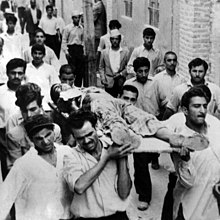1963 demonstrations in Iran
| 15 Khordad incident | |||
|---|---|---|---|
| Part of the Iranian Revolution | |||
 People of Tehran in the demonstrations with pictures of Ruhollah Khomeini in their hands. | |||
| Date | 5 June 1963 | ||
| Location | |||
| Resulted in | Protests suppressed | ||
| Parties | |||
| |||
The demonstrations of June 5 and 6, also called the events of June 1963 or (using the
Background
In 1963,
Events
Khomeini's sermon and arrest

On the afternoon of June 3, 1963,
Two days later at three o'clock in the morning, security men and commandos descended on Khomeini's home in Qom and arrested him. They hastily transferred him to the
Uprising

As dawn broke on June 5, the news of his arrest spread first through Qom and then to other cities. In Qom, Tehran,
According to journalist Baqer Moin, police files indicate 320 people from a wide variety of backgrounds, including 30 leading clerics, were arrested on June 5. The files also list 380 people as killed or wounded in the uprising, not including those who did not go to hospital "for fear of arrest", or who were taken to the morgue or buried by security forces.[12]
Release of Khomeini

Hardliners in the regime, such Prime Minister Asadollah Alam and SAVAK head Nematollah Nassiri, favored execution of Khomeini, as one responsible for the riots, and less-violent strikes and protests continued in bazaars and elsewhere. Fateme Pakravan – wife of Hassan Pakravan, chief of SAVAK – says in her memoirs that her husband saved Khomeini's life in 1963. Pakravan felt that his execution would anger the common people of Iran. He presented his argument to the Shah. Once he had convinced the Shah to allow him to find a way out, he called on Ayatollah Mohammad Kazem Shariatmadari, one of the senior religious leaders of Iran, and asked for his help. Shariatmadari suggested that Khomeini be declared a Marja. So, other Marjas made a religious decree which was taken by Pakravan and Seyyed Jalal Tehrani to the Shah.[13] Pakravan's saving of Khomeini's life cost him his own. After the revolution when he was given a death sentence, a personal contact of Pakravan with close ties to Khomeini went to seek his pardon and reminded Khomeini that Pakravan had saved his life, to which Khomeini replied "he should not have."
After nineteen days in the Qasr Prison, Khomeini was moved first to the Eshratabad military base and then to a house in the Davoodiyeh section of Tehran where he was kept under surveillance. He was released on April 7, 1964, and returned to Qom.[10]
After the revolution
The date of 15 Khordad is widely noted throughout the Islamic Republic of Iran. Among other places, the intersection known as
References
- ^ Rahnema, Ali (February 20, 2013) [December 15, 2008]. "JAMʿIYAT-E MOʾTALEFA-YE ESLĀMI i. Hayʾathā-ye Moʾtalefa-ye Eslāmi 1963-79". Encyclopædia Iranica. Fasc. 5. Vol. XIV. New York City: Bibliotheca Persica Press. pp. 483–500. Retrieved March 15, 2016.
...the initial organization and mobilization of the demonstrations that occurred in Tehran after the arrest of Khomeini on 5 June 1963, was the work of the Coalition...
- ISBN 9781137578259.
The Freedom Movement participated actively in the 1963 uprising, instigated by Khomeini. The leading and younger members of the movement were imprisoned after the event.
- ^ Hosseini, Mir M. "The 15 Khordad Uprising". The Iranian History Article. Archived from the original on October 18, 2012. Retrieved 5 June 2017.
- OCLC 255085717.
- Bio.Retrieved June 3, 2012.
- ISBN 978-1-86064-128-2.
- ^ ISBN 978-0-521-20095-0.
- ISBN 978-1-86064-626-3.
- ISBN 978-1-4381-3236-5.
- ^ a b c "History of Iran: Ayatollah Khomeini".
- OCLC 255085717.
- ^ OCLC 255085717.
- ISBN 978-0-932-88519-7.

